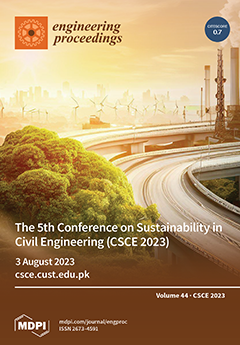Eng. Proc., 2023, CSCE 2023
The 5th Conference on Sustainability in Civil Engineering (CSCE)
Online | 3 August 2023
Volume Editors:
Majid Ali, Capital University of Science and Technology
Muhammad Ashraf Javid, Capital University of Science and Technology
Shaheed Ullah, Capital University of Science and Technology
Iqbal Ahmad, Capital University of Science and Technology
Printed Edition Available!
- Issues are regarded as officially published after their release is announced to the table of contents alert mailing list.
- You may sign up for e-mail alerts to receive table of contents of newly released issues.
- PDF is the official format for papers published in both, html and pdf forms. To view the papers in pdf format, click on the "PDF Full-text" link, and use the free Adobe Reader to open them.




